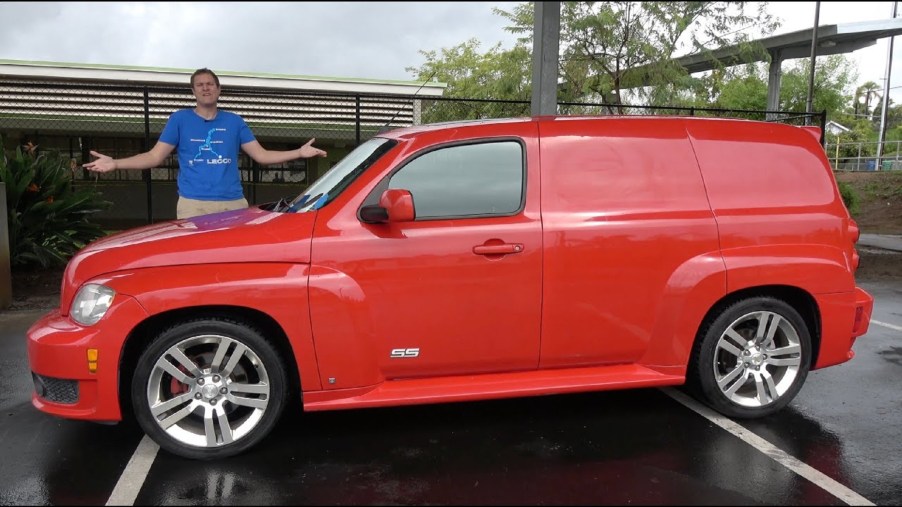
The Chevy HHR Makes for an Odd High-Performance Panel Van
Besides the Corvair-based Greenbrier, Chevrolet’s panel vans tend to be less about quirks than practicality. Though, admittedly the Greenbrier’s rear-engine layout was chosen for practical reasons. However, panel vans’ cousins, wagons and minivans, have shown that practicality can come with attractive design or even high-power performance. The retro-styled Chevy HHR may have been more car than a van, but it did have panel-van-like practicality. But Chevy made a performance variant, too, the HHR SS. And, as with the Impala SS, there was more to it than just the badge.
Chevy HHR SS Panel specs and interesting features
Doug Demuro recently got behind the wheel of a 2009 Chevy HHR SS Panel. Which is actually a surprisingly rare car.

Although the HHR was produced from 2006-2011, the Panel trim came for the 2007 model year, Autotrader reports. Having missed the PT Cruiser’s high point, Chevy wanted to broaden the wagon’s appeal and recoup costs. To further broaden it, the SS trim was added for the 2008 model year, Motor Trend reports.

And then, in 2009, the two were combined into the Chevy HHR SS Panel. However, due to the Great Recession, only 216 examples were ever built, and only for 2009. There are literally more Ferrari Enzo supercars in the world than there are HHR SS Panels.
But rarity isn’t the Chevy HHR SS Panel’s only quirk. For example, to turn the HHR into a panel van, engineers removed the rear seats and installed a rugged cargo floor. The rear windows were also removed—for safety—as were the rear door handles. But the rear doors are still there, and they can still be opened from inside. Or, if you prefer, they open via the key fob, as well as by buttons on the dashboard.

The rear tailgate unlatches electronically, which is excellent until the battery dies. And instead of fitting a conventional external keyhole, the Chevy HHR Panel gets a hidden manual release. However, the wagon-turned-van does have some practical features, too.
The cargo floor has built-in compartments, as well as an under-floor storage area. There’s also a 12V power outlet and door lock/unlock switch in the rear. And the Chevy HHR Panel retained its rear seat mounting points, so they can be used for attaching bungee cords, cargo nets, or similar devices.
Then there are the SS features.
What’s it like to drive?
Instead of the standard car’s naturally-aspirated four-cylinders, Car and Driver reports, the Chevy HHR SS has a 2.0-liter turbocharged four-cylinder. With the 4-speed automatic, it made 250 hp and 223 lb-ft. With the 5-speed manual, though, it made 260 hp and 260 lb-ft. 0-60 time dropped from about 7.5 seconds with the 4-speed to 6.5 with the 5-speed.
Both versions have modified stability control and launch control, but the manual also has no-lift shifting. And yes, there were manual-equipped Chevy HHR SS Panels built—roughly 50 or 60. There was also an SS Performance Pack available. This added a limited-slip differential and Brembo front brakes.
However, as Popular Mechanics explains, the Chevy HHR SS received more than just a different engine. The SS has trim-specific springs, dampers, and anti-roll bars tweaked at the Nurburgring. Chevy also modified the steering and even repositioned the shifter for shorter throws. That required modifying the center console, and relocating the window switches.

In addition, the Chevy HHR SS also got a configurable, albeit tiny, center screen. It displays various performance-related gauges, including ones for horsepower and turbo boost. It can also show each tire’s pressure, ignition timing, and even external air pressure. Plus, even for automatics, it has a shift light.

According to Demuro, this panel wagon still feels reasonably quick today. Car and Driver reports that the HHR SS was only slightly heavier than the contemporary Mazdaspeed 3. And even with traction control disabled, the front-wheel-drive HHR SS never really torque steered. MT reports the modified suspension helps with that, as well as improving the wagon’s overall handling appreciably. The Chevy HHR SS isn’t quite a hot hatch—but it’s not far off from that level of performance.
Chevy HHR SS Panel pricing
Because of its rarity, a low-mileage 2009 Chevy HHR SS Panel commands a sizable premium over the regular SS.

As of this writing, a 9731-mile example, with a manual, is listed at $27,000 on Autotrader. It appears to be the same one The Drive reported was listed at $33,000 in December 2019. That’s in contrast with non-Panel Chevy HHR SS models, which regularly go for under $10,000.
The Chevy HHR SS Panel, then, is definitely an oddball. But it is, at least, getting its due.
Follow more updates from MotorBiscuit on our Facebook page.


